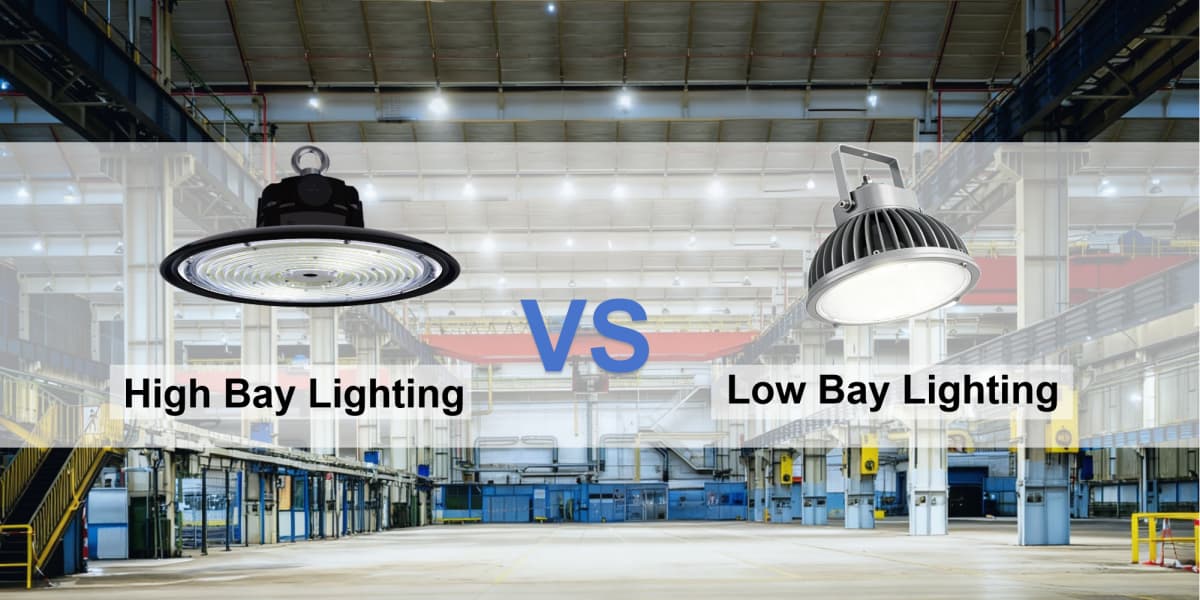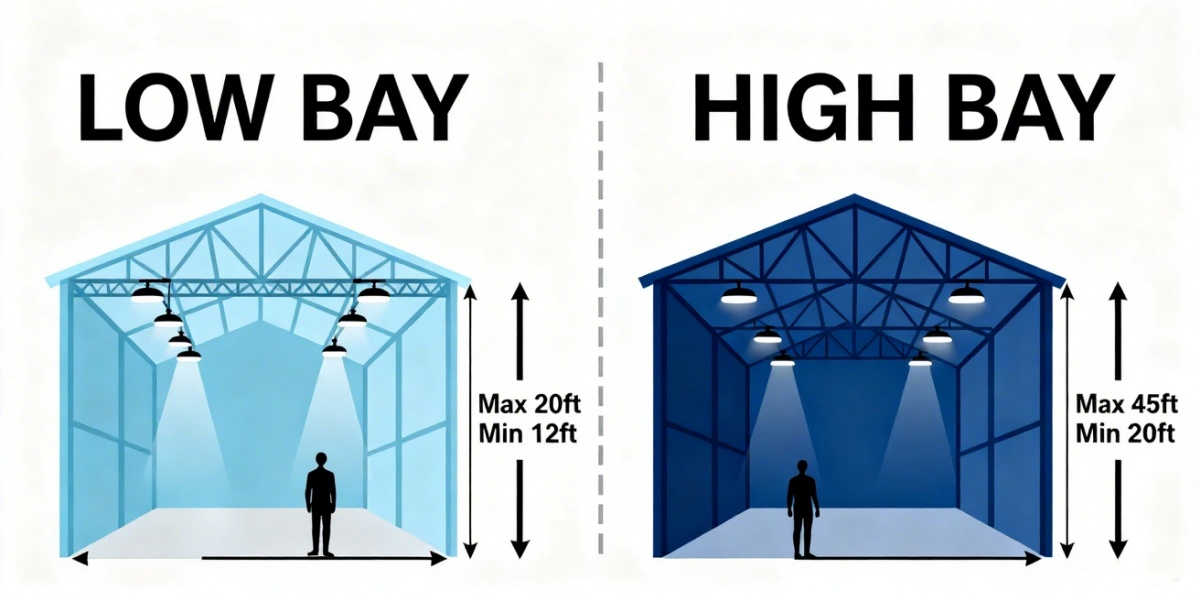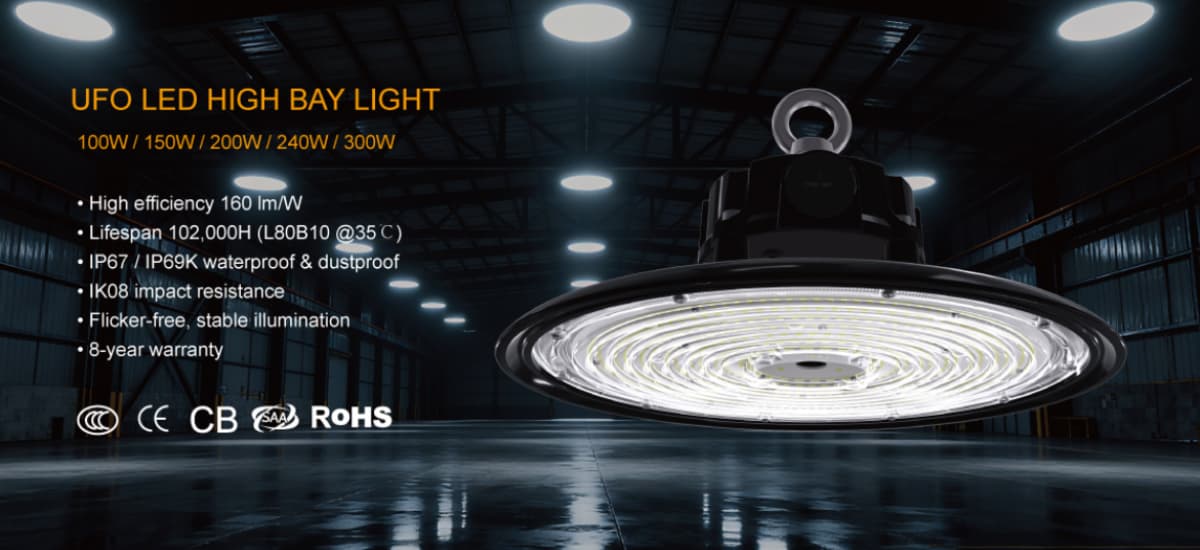Hochregal- vs. Niedrigregalbeleuchtung: Was ist der wirkliche Unterschied?

Einführung
Wenn Sie jemals an Ihre Fabrikdecke gestarrt und sich gefragt haben: „Warum hängen da so viele verschiedene Lampen?“, sind Sie nicht allein. Die Frage, ob man eine Hochregal- oder eine Niedrigregalbeleuchtung verwenden sollte, hat schon so manchen Lagerleiter und Bauunternehmer vor ein Rätsel gestellt.
Man kann es sich so vorstellen: Hochregalleuchten sind die leistungsstarken Flutlichter der Industrie – sie sind dafür gebaut, von den Dachsparren herabzuleuchten. Niedrigregalleuchten hingegen sind ihre bodenständigen Verwandten, perfekt für Räume, die keine himmelhohe Beleuchtung benötigen.
In diesem Leitfaden erklären wir die Unterschiede zwischen diesen beiden Beleuchtungsarten, wo die jeweilige Art am besten geeignet ist und warum die moderne LED-Technologie die Spielregeln für immer verändert.
Inhaltsverzeichnis
Worin besteht der Unterschied zwischen High-Bay- und Low-Bay-Beleuchtung?
LED- vs. Leuchtstoffröhren-Hallenbeleuchtung: Welche ist leistungsstärker?
LED-Hochregalleuchten vs. LED-Niedrigregalleuchten
Welche sollten Sie wählen – High Bay oder Low Bay?
Wie wählt man die richtige Hallenbeleuchtung für seine Einrichtung aus?
Warum LED-Hallenstrahler die Zukunft der Industriebeleuchtung sind
Was ist Bay Lighting?
Hallenbeleuchtung bezeichnet Beleuchtungssysteme für große, offene Innenräume wie Fabriken, Lagerhallen, Sporthallen und große Einzelhandelsgeschäfte. Diese Bereiche benötigen eine helle und gleichmäßige Ausleuchtung, damit die Mitarbeiter gut sehen, sich sicher bewegen und produktiv arbeiten können.
Vereinfacht gesagt, wird die Beleuchtung von Erkerfenstern anhand der Deckenhöhe in zwei Typen unterteilt :
Hochregalbeleuchtung – wird für Deckenhöhen von mehr als etwa 20 Fuß verwendet.
Niedrige Hallenbeleuchtung – wird für Deckenhöhen unter etwa 20 Fuß verwendet.
Dieser Unterschied ist deshalb wichtig, weil je höher die Decke ist, desto stärker und schmaler der Lichtstrahl sein muss, um genügend Licht auf den Boden zu bringen.
Früher wurden in vielen Anlagen Metallhalogenid- oder Leuchtstofflampen verwendet.
Heute ist die LED-Hallenbeleuchtung dank ihrer Energieeffizienz, langen Lebensdauer und gleichmäßigen Helligkeit zum Standard geworden. Sie bietet eine zuverlässige und wartungsarme Beleuchtung für Industrie- und Gewerbeflächen.
Worin besteht der Unterschied zwischen High-Bay- und Low-Bay-Beleuchtung?
Bei der Planung von Industrie- oder Gewerbebeleuchtungskonzepten ist es unerlässlich , den Unterschied zwischen Hallenstrahlern und Flachstrahlern zu verstehen . Beide eignen sich für große Räume, ihre Installation und Leistung variieren jedoch je nach Deckenhöhe, Helligkeitsbedarf und Lichtverteilung.
(1) Installationshöhe
Der erste und wichtigste Faktor ist die Deckenhöhe .
Hallenstrahler sind für Deckenhöhen über 6 Metern (20 Fuß) konzipiert . Sie liefern starkes, fokussiertes Licht, das den Boden erreicht, ohne an Helligkeit zu verlieren.
Low bay lights work best for ceilings below 20 feet. They spread light more widely to avoid over-bright spots or glare.
Choosing the wrong type can cause wasted energy or uneven lighting.

(2) Application
High bay lighting is commonly used in warehouses, production halls, aircraft hangars, and sports arenas — any area with tall ceilings and large vertical space.
Low bay lighting fits workshops, retail stores, garages, and assembly rooms, where ceilings are lower and workers need softer, wider illumination.
The right match improves both safety and visibility in daily operations.
(3) Beam Angle
Beam design also separates the two types.
High bay fixtures use narrower beams (60°–90°) to push light farther down.
Low bay fixtures have wider beams (100°–120°) to spread light evenly at lower heights.
This ensures consistent brightness across the workspace.
(4) Mounting
High bay lights are typically hung by chains, hooks, or pendants, while low bay lights are often surface-mounted or suspended at shorter distances. The mounting method helps control light spread and maintenance access.
(5) Wattage & Lumen Output
The performance difference is clear in numbers:
High bay: 150–400W, producing about 15,000–40,000 lumens.
Low bay: 60–150W, producing about 6,000–15,000 lumens.
In summary: high bay lighting focuses light from greater heights; low bay lighting spreads it closer to the ground. Knowing this distinction ensures you select the right fixture for optimal efficiency and comfort in your facility.
LED vs Fluorescent Bay Lighting: Which Performs Better?
When comparing LED bay lights vs fluorescent, the difference in performance and long-term value is clear. LEDs have quickly become the preferred choice for factories, warehouses, and workshops across Europe and the US.
Energy Efficiency
LED bay lights use up to 70% less energy than fluorescent fixtures while producing the same or higher brightness. This means lower electricity bills and smaller carbon footprints — both major advantages for modern industrial facilities.
Brightness & Quality
LEDs provide consistent, flicker-free light with better color rendering. Workers can see details and colors more accurately, improving safety and productivity. Fluorescent lights, in contrast, tend to flicker, fade, and lose brightness over time.
Maintenance & Lifespan
A quality LED bay fixture can last 50,000 hours or more, often five times longer than fluorescent tubes. There are no ballasts to replace and no fragile glass to handle.
Instant-On & Control
LEDs turn on instantly and integrate easily with motion sensors or smart controls, something fluorescent lights can’t do effectively.
For these reasons, LEDs dominate industrial retrofits — offering stronger light, lower costs, and less downtime for maintenance.
High Bay LED Lights vs Low Bay LED Lights
When both lighting types move into the LED era, the difference between high bay LED lights vs low bay LED lights becomes more about engineering design than basic height or brightness.
Optical Design
LED technology allows light to be shaped with precision lenses rather than old-style reflectors.
High bay LEDs use narrow, high-intensity lenses to push light down from 20–50 feet, ensuring uniform brightness across tall spaces.
Low bay LEDs use wider beam optics to cover shorter distances with softer, more comfortable light.
This optical control reduces glare and improves energy efficiency per lumen.
Heat Dissipation
Because high bay fixtures run at higher wattages, they require larger aluminum heat sinks or active cooling designs to protect LED chips. Low bay units generate less heat, so they often feature compact passive cooling that keeps fixtures lighter and easier to mount.
Smart Controls & Integration
Modern industrial LED lighting supports motion sensors, daylight harvesting, and IoT control systems. High bay models often use networked or wireless systems for energy savings in warehouses, while low bay lights integrate simple occupancy sensors for smaller areas.
Efficiency & Reliability
Both types now exceed 150 lumens per watt, offering powerful, consistent light with minimal maintenance.
Ceramiclite provides high bay LED lighting solutions designed for industrial environments — combining optical precision, durable materials, and smart control compatibility to meet diverse facility needs.
Which Should You Choose — High Bay or Low Bay?
Now that we've outlined the key differences, you're probably wondering: "So which one is right for MY space?" The right choice boils down to your ceiling height, lighting needs, and work environment.
Instead of getting lost in the details, use the quick-reference guide below to make an initial determination.
The right choice depends on your ceiling height, lighting needs, and work environment. Each type serves a specific purpose, and picking the right one ensures both efficiency and comfort.
Here’s a quick guide to help you decide:
Condition | Recommended Lighting | Reason |
Ceiling above 20 ft (6 m) | High Bay | Delivers concentrated brightness with a narrow beam angle to reach the floor evenly. |
Ceiling below 20 ft | Low Bay | Offers a wider beam for softer, more diffused light. |
Warehouses / factories / gymnasiums | High Bay | Designed for high illumination intensity and large spaces. |
Retail stores / garages / workshops | Low Bay | Provides balanced brightness and better visual comfort for smaller areas. |
Tip: When in doubt, choose based on your lux requirement — high bay for power, low bay for comfort.
For a more detailed analysis of each factor—like calculating exact brightness needs or selecting the perfect beam angle—continue to the next section, where we break down the complete selection process.
How to Choose the Right Bay Lighting for Your Facility?
Selecting the right fixture can make or break your lighting performance. When you choose the right bay lighting, the goal is simple — achieve consistent brightness, reduce energy costs, and maintain long-term reliability. Here’s a quick guide to help you decide.
(1) Beam Angle and Width
Start with your ceiling height.
For ceilings above 20 ft, use narrower beams (60°–90°) to concentrate light on the work floor.
For ceilings below 20 ft, choose wider beams (100°–120°) for smoother, more even coverage.
This ensures your light reaches the right area without glare or dark spots.
(2) Mounting & Distribution
Consider your mounting options: chain, pendant, or surface mount.
High bay fixtures are often suspended to control light spread.
Low bay fixtures can be surface-mounted for a cleaner look.
Proper mounting height directly affects light distribution and maintenance access.
(3) Retrofitting Existing Fixtures
If your facility already uses older metal halide or fluorescent lights, LED retrofits are the fastest way to cut energy use and improve brightness. They fit existing mounts, minimizing installation cost and downtime.
(4) Power & Brightness
Use lumens per square foot as your guide:
Storage areas: 10–20 lm/ft²
Assembly or production: 30–50 lm/ft²
Inspection zones: 70+ lm/ft²
Focus on lumen output, not just wattage, to ensure efficient lighting design.
(5) Color Temperature
A neutral white tone between 4000K and 5000K gives the best visibility for industrial work. It reduces eye strain and enhances material contrast.
(6) Shape: UFO vs Linear Fixtures
UFO high bay lights deliver strong, centralized illumination — ideal for large, open areas.
Linear low bay lights spread light evenly across aisles or production lines, perfect for lower ceilings and rectangular layouts.
Visualizing this helps match fixture shape with your room geometry.
(7) Energy Usage & ROI
Calculate your return on investment (ROI) based on energy savings, lifespan, and reduced maintenance. Most LED systems pay for themselves within 1–2 years, then continue saving for over a decade.
By following these steps, facility managers and engineers can confidently select lighting that improves safety, productivity, and energy efficiency — all while ensuring the best long-term value for their operation.
Why LED Bay Lights Are the Future of Industrial Lighting?
The shift toward LED bay lights is more than a trend — it’s the future of industrial lighting. Across Europe and the US, factories and warehouses are moving away from traditional fixtures to smarter, more efficient LED systems that support long-term sustainability goals.
Modern LED bay lights do more than just illuminate. They connect. Integrated motion sensors, daylight harvesting, and IoT controls allow lights to adjust automatically based on occupancy or ambient light levels. This reduces wasted energy and extends fixture lifespan while keeping workspaces consistently bright and safe.
Governments and corporations are also driving change. Energy-efficiency standards and ESG requirements now encourage facilities to cut power use and carbon emissions. LEDs make compliance simple — delivering high output with low consumption.
Looking ahead, LED lighting will become the backbone of smart, data-driven facilities, where lighting systems communicate with HVAC, security, and production networks.
Ceramiclite’s HB01 High Bay LED bay lights are engineered with these innovations in mind — combining optical precision, smart compatibility, and industrial-grade durability. They’re ready for today’s efficiency demands and tomorrow’s intelligent infrastructure.
Want to know more about What is New in Industrial LED Lighting?
Conclusion
Choosing between high bay vs low bay lighting comes down to three key factors — ceiling height, beam angle, and brightness needs. High bay lights deliver powerful, focused illumination for tall spaces, while low bay lights provide softer, wider coverage for lower ceilings.
Upgrading to LED bay lighting ensures higher efficiency, lower maintenance, and long-term ROI — a smart move for any modern facility.
Sie sind sich noch nicht sicher, welche Option am besten zu Ihren Räumlichkeiten passt? Fordern Sie noch heute eine kostenlose Lichtplanung von Ceramiclite an und entdecken Sie die perfekte Balance aus Leistung, Kosteneinsparung und Zuverlässigkeit für Ihre industrielle Umgebung.
_thumb.jpg)

